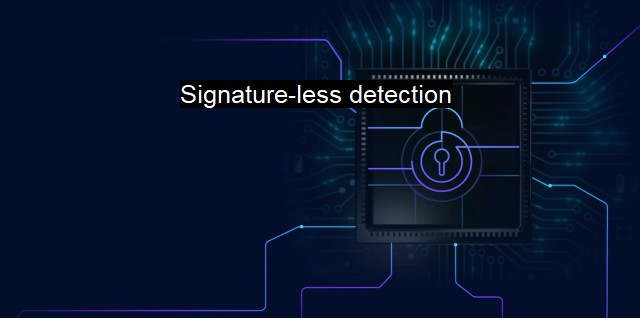What is Signature-less detection?
Signature-less Detection: A New Approach to Cybersecurity
"Signature-less detection" is a relatively new approach in the field of cybersecurity for identifying and addressing threats. Unlike traditional methods, which rely on already known virus signatures or pattern matching, signature-less detection does not require prior knowledge of the form of attack. This approach enables real-time detection and prevention of novel threats or previously unidentified malicious software (malware), thus proactively protecting an organization's network.Rooted in the concept that every malicious operation has a distinct behavioral footprint or anomalous pattern, signature-less detection uses advanced algorithms and machine learning (ML) techniques to analyze these behaviors in real-time. The method tracks processes happening in the infrastructure and identifies irregularities that might indicate malicious attacks like a zero-day exploit. As such, signature-less detection nullifies threats as they arise without waiting for an update from blacklist databases.
It's crucial to understand that traditional signature-based solutions are still valid but have limitations in their application. They can usually protect an organization from known malware variants by monitoring for recognized patterns or identifiers. They follow a security database that lists all known types of malicious objects. While highly effective against known threats, traditional antivirus software is unable to cope with the evolving tactics of cyber attackers who continuously devise new ways of launching their attacks. More so, cybercriminals often use obfuscation techniques and polymorphic code to beat signature-based solutions, leading to successful breaches into organizational systems.
Within this context, the signature-less detection technology emerged as a response to the increasing complexity and sophistication of targeted attacks, which have outpaced the capabilities of signature-based detection approaches. In the continually changing cyber threat landscape, the traditional approaches fail to provide complete protection. This gap accounted for the popularity and adoption of signature-less security features.
Signature-less detection operates based on the premise of detecting unknown objects and anomalies rather than established types of malware. Among the signature-less methods is Containerizing, which allows all internet traffic to be opened and run in a virtual environment, what we call a sandbox. Sandboxing effectively quarantines potential threats before they reach the machine itself, it offers a space where suspected malicious files can be executed safely for analyzing and monitoring their behaviors without jeopardizing the actual infrastructure. Another robust technique employed is memory scanning, a process that scrutinizes a program’s memory space in search of malicious patterns even if the malicious software alters its signature frequently.
Application control processes help hinder threats by only granting access to approved applications, hence shutting out unauthorized and possibly harmful software. This method emphasizes prevention ahead of infection, recognizing harmful codes even before they penetrate the system.
Machine learning and artificial intelligence also form an integral part of the signature-less detection landscape, thanks to their ability to learn and adapt to changing cyber threats. Machine learning models can ludicrously identify suspicious activities that breach the normal behavioral threshold, learning and adapting from the millions of legitimate and malicious file data points.
Despite the inherent shortfalls like high false positives and the need for constant system tweaking to maintain maximum effectiveness, signature-less detection continues to evolve and define the cybersecurity industry's future. It could prove to be a potent tool in the fight against unknown and emerging cyber threats yet unseen.
Undoubtedly, the significance of signature-less detection extends beyond just a protective mechanism. In an environment where cyber threats mutate rapidly, it guarantees a proactive, robust, and superior protection level compared to various current cybersecurity protocols. While the conventional methods may continue to play a critical part in internet security, signature-less detection enhances overall system protection compilers assuring comprehensive defense curtains against known, unknown, evolving, and sophisticated threats.

Signature-less detection FAQs
What is signature-less detection?
Signature-less detection refers to a type of cybersecurity technique that does not rely on pre-defined virus signatures to detect and prevent malware attacks. Instead, it uses advanced algorithms, machine learning, behavior analysis, and other techniques to identify and stop new and unknown threats in real-time.How does signature-less detection differ from traditional antivirus software?
Traditional antivirus software relies on virus signatures to detect and block malware. This means that if a virus has not been previously detected and its signature not present in the database, the antivirus is unlikely to recognize the threat. Signature-less detection, on the other hand, focuses on detecting malicious behavior and abnormalities to identify new and unknown threats that do not have pre-defined signatures.What are the benefits of using signature-less detection?
Using signature-less detection can provide a higher level of protection against new and unknown malware threats compared to traditional antivirus software. It can also help to reduce false positives, which means legitimate applications and files are less likely to be mistakenly flagged as malware. Additionally, signature-less detection can be more effective in detecting sophisticated and targeted attacks.Is signature-less detection 100% effective?
No, like any other cybersecurity technique, signature-less detection is not 100% effective. Although it can provide better protection against new and unknown threats, it is still possible for attackers to develop malware that can evade detection. It is important to implement multiple layers of security to minimize the risk of successful attacks.| | A | | | B | | | C | | | D | | | E | | | F | | | G | | | H | | | I | | | J | | | K | | | L | | | M | |
| | N | | | O | | | P | | | Q | | | R | | | S | | | T | | | U | | | V | | | W | | | X | | | Y | | | Z | |
| | 1 | | | 2 | | | 3 | | | 4 | | | 7 | | | 8 | | |||||||